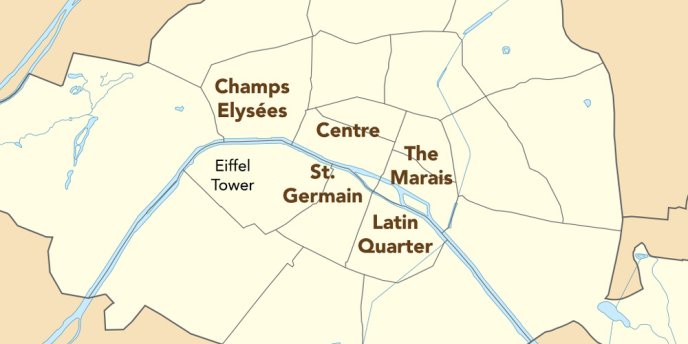Paris Arrondissements – Exploring The Heart Of The Neighborhoods
To understand Paris, you'll want to familiarize yourself with its neighborhoods. Paris is divided into twenty arrondissements, each with its own unique personality and charm. From the iconic landmarks of the 1st, where the Louvre and Palais Royal reign supreme, to the vibrant, bohemian energy of the 18th, home to Montmartre and Sacré-Coeur, every district tells its own story. Whether you're wandering the cobbled streets of the Marais or exploring the upscale boutiques of the 8th, you'll find that Paris offers a distinct experience in every corner.
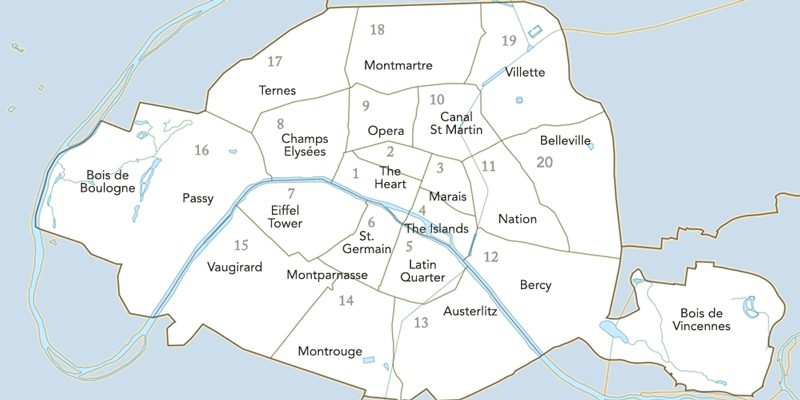 Map of the Paris Arrondissements, Wikimedia by Eric Gaba & Mark Craft
Map of the Paris Arrondissements, Wikimedia by Eric Gaba & Mark Craft
Navigating the arrondissements is like peeling back the layers of the city. Each neighborhood moves with its own rhythm, offering a mix of history, culture, and modern life. With this guide, you'll discover the best of Paris' districts, from the bustling heart of the city to the quieter, hidden gems that locals love. Explore the diverse and dynamic essence of Paris through its arrondissements.
Where to Stay in Paris
The City of Light is equally La Ville des Quartiers — the city of neighborhoods. Paris is made up of so many charming districts, each with nice hotels, that it might be hard for the visitor to choose where to stay and which hotel to book. That's where where our curated Guide to Where to Stay in Paris comes in handy. We share the five best neighborhoods for the visitor to call home and pick out the top-rated hotels in each one. Bon voyage and bon séjour.
1st & 2nd Arrondissements – The Heart of Paris
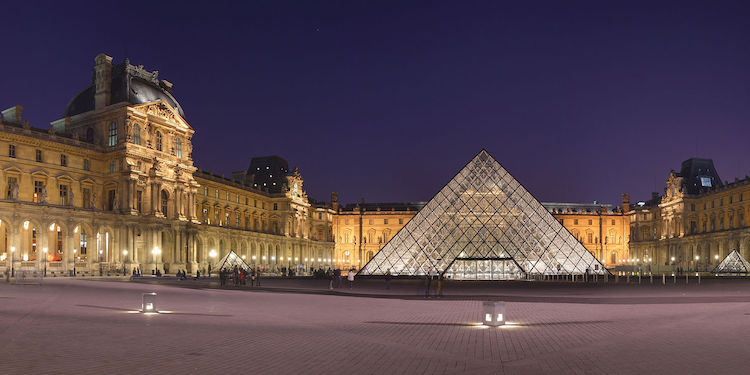 Courtyard of the Louvre Museum, 1st Arrondissement, photo Wikimedia by Benh Lieu Song
Courtyard of the Louvre Museum, 1st Arrondissement, photo Wikimedia by Benh Lieu Song
For centuries the seat of royal power in France, these two historic Paris districts comprise the heart of Paris. Home to many iconic Paris attractions — Palais Royal, the Louvre Museum, lovely Jardin des Tuileries, , Place de la Concorde — it's is a very popular locale for travelers to call home.
The 3rd & 4th Arrondissements – The Marais
 Place des Vosges, 4th Arrondissement
Place des Vosges, 4th Arrondissement
Encompassing the 3rd and 4th Arrondissements, the Marais is one of the oldest and most charming quartiers of the city. Here's where you'll find trendy shops, the liveliest alternative community, the hub of the Jewish community, the Hotel de Ville, and popular restaurants frequented by Parisians. It's also home to Place de Vosges, the first royal park in Paris open to the public.
![]()
Delicious Activities in the Marais
|
Marais Food & Wine Tour |
Cheese & Wine Tasting in a Paris Cellar |
|
Cheese & Wine Tasting in a Paris Cellar |
The Islands of Paris
 Île de la Cité from Ponts des Arts, photo by Mark Craft
Île de la Cité from Ponts des Arts, photo by Mark Craft
Join us on an island-hopping tour in Paris! Île de la Cité and Île St. Louis are two of the most romantic places to stay in Paris. Home to Notre Dame Cathedral, La Sainte-Chapelle, and the Concierge, the two islands also have cute, tiny parks, green spaces and, cafes overlooking the Seine River.
The 5th Arrondissement – The Latin Quarter
 A street in the The Latin Quarter, 5th Arrondissement
A street in the The Latin Quarter, 5th Arrondissement
The 5th Arrondissement, AKA the Latin Quarter, may be the most well-known district of Paris. It's ancient, too — dating back to when Paris was a Roman settlement. Here you'll find the Pantheon; the Sorbonne; Rue Mouffetard, the bustling market district; and winding cobblestone streets. No wonder many travelers (including us) choose to stay here when visiting Paris.
![]()
Experience The Left Bank Of Paris
|
Dinner & Cabaret at Paradis Latin Theater |
Chocolate & Pastry Walking Tour of Saint-Germain-des-Prés |
|
Chocolate & Pastry Walking Tour of Saint-Germain-des-Prés |
The 6th Arrondissement – St-Germain-des-Prés
 Saint-Germain-des-Prés, 6th Arrondissement
Saint-Germain-des-Prés, 6th Arrondissement
One of the prettiest areas in Paris, Saint-Germain-des-Prés was the haunt of both the French existentialists and the Americans of the Lost Generation. Home to the Jardin du Luxembourg and the church of St-Germain-des-Prés, travelers choose to stay in St Germain for the luxe shopping, the famous cafes, and the parks.
The 7th Arrondissement – The Eiffel Tower
 The 7th Arrondissement's most ionic sight
The 7th Arrondissement's most ionic sight
The 7th Arrondissement, home to the Eiffel Tower, the grandest symbols of Paris, is where you'll also find Musée d'Orsay, Les Invalides, and the Rodin Museum. Travelers choose to stay here for the glittering facades, wealthy residential streets, tree-lined parks, the banks of the Seine, the famous food street Rue Cler, and a string of lovely restaurants and hotels. We think it's one of the most attractive quartiers in Paris — the Eiffel Tower is just a bonus!
The 8th Arrondissement – Champs-Elysées
 Arc de Triomphe, at the end of Champs-Elysées, 8th Arrondissement
Arc de Triomphe, at the end of Champs-Elysées, 8th Arrondissement
The 8th Arrondissement is known for luxury. If you have a comfortable bank account and a taste for the good things in life — luxury hotels, great museums, and chi-chi shopping — this is where you should stay. Parc Monceau, one of the most civilized parks in the city, is also found in this wealthy arrondissement. Champs-Elysées itself is bookended by Place de la Concorde and the Arc de Triomphe.
The 9th Arrondissement – Opéra
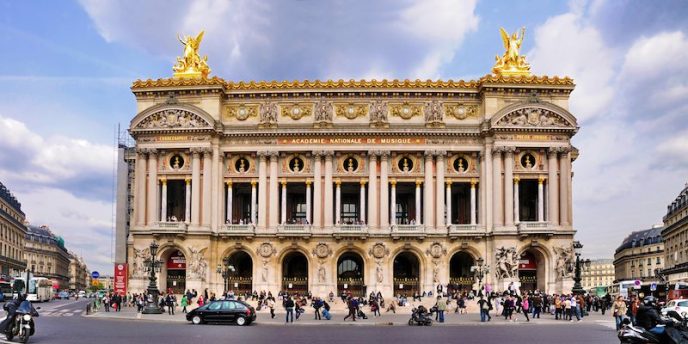 Palais Garnier at Place de la Opéra, 9th Arrondissement
Palais Garnier at Place de la Opéra, 9th Arrondissement
Love to shop? Famous for the Grands Magasins — Galeries Lafayette and Printemps department stores — the 9th is home to a plethora of shopping brands. For many, though, it's most famous for the beautiful 19th-century Paris opera house, Palais Garnier. For a restful night after shopping, there are many, many attractive hotels. Discover what to do and see in the 9th Arrondissement.
10th Arrondissement – Les Gares
 Gare de l'Est, photo Wikimedia by Gilbert Bochenek
Gare de l'Est, photo Wikimedia by Gilbert Bochenek
If you love interesting, mixed, even funky neighborhoods, head to this arrondissement of northeast of central Paris. Home to the two largest gares in Paris as well as the northern tip of Canal St-Martin, the 10th is full of life, thrift shops, off-the-beaten-path restaurants, some surprisingly good hotels, and lots of Parisians. In our guide we reveal what makes the 10th tick.
11th Arrondissement – Canal Saint-Martin
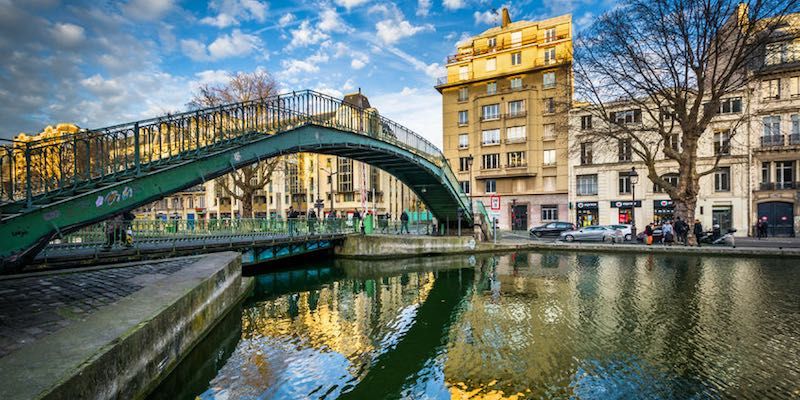 Canal Saint-Martin, 11th Arrondissement
Canal Saint-Martin, 11th Arrondissement
This up-and-coming neighborhood straddles the canal as it winds through the 10th and 11th Arrondissements. Today it's a popular neighborhood where young Parisians live, attracted by cheaper rents and trending restaurants and cafes. You can also hop on a canal boat for a leisurely ride through the locks and on to the Seine River. Let's find out what makes Canal Saint-Martin (and the rest of the 11th Arrondissement) so attractive.
12th Arrondissement – The Far East
 Aligre Market, 12th Arrondissement, photo by Mark Craft
Aligre Market, 12th Arrondissement, photo by Mark Craft
The 12th is full of things we really like — the modernistic Opera Bastille; the Aligre market; Gare de Lyon, the loveliest train station in Paris; Bercy Village; and a great promenade pathway built along an old rail line. Travelers choose to stay here for activities, the cheaper hotels, and the lively neighborhoods.
The 13th Arrondissement – Something New, Something New
 Cité de la Mode, 13th Arrondissement
Cité de la Mode, 13th Arrondissement
The 13th Arrondissement doesn't feature historic monuments, cobblestone streets, or vestiges of Roman Paris to attract the visitor. Here you find more of the Paris of the 20th century, thanks to extensive modern projects and rebuilding, such as the postmodern high-rise, Bibliothèque Nationale de France and the neighboring new quartier of Paris Rive Gauche. But there are still the traditional Parisian street markets, an historic train station, a swimming pool floating on the Seine, and a dynamic new arts and entertainment and activities scene, often re-purposing former industrial buildings
The 14th Arrondissement – The South
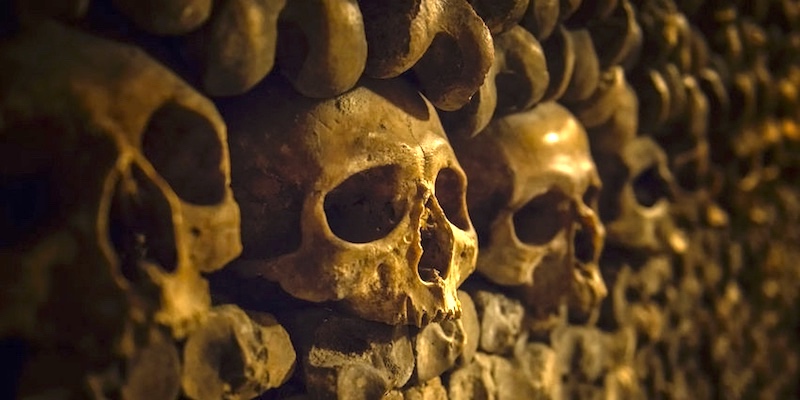 The Paris Catacombs, located in the 14th Arrondissement
The Paris Catacombs, located in the 14th Arrondissement
140,000 Parisians can't be wrong about the attractions of this southern district. That's how many live, work, shop, and play in the 14th Arrondissement. Although this is another area not normally on travelers' list of places to visit in Paris, we find there's a lot to like about the 14th — including these twelve suggestions.
The 15th Arrondissement – The Far Left Bank
 Lunching al fresco in the 15th Arrondissement, photo by Mark Craft
Lunching al fresco in the 15th Arrondissement, photo by Mark Craft
The 15th Arrondissement is another quartier not often on the top of visitors' hotel checklists, but the cozy neighborhood has much to recommend it. This large arrondissement tucks up against the Seine on the Left Bank, across from the 16th. Hotels cost less and are found close to Gare Montparnasse, the Tour Montparnasse skyscraper, plus the charming shopping street of Rue du Commerce, the Grenelle Market, and Parc André Citroën. So, let's hop on Metro Line 8 or 12 and meet up in southwest Paris!
The 16th Arrondissement – From the Arc to the Bois
 The view from Trocadero in the 16th Arrondissement, photo by Mark Craft
The view from Trocadero in the 16th Arrondissement, photo by Mark Craft
The westernmost arrondissement stretches from the Arc de Triomphe to the vast Bois de Boulogne. It's home to Musée Marmottan, where we go to to view the Monets; to luxury shopping and spectacular food markets; and to some of the most sought-after residential real estate in Paris. The plaza at Trocadero is a well-known and much-visited landmark found just across the Seine from the Eiffel Tower. Go there for some of the best views in Paris. This arrondissement is also home to many of the most glamorous luxury hotels in Paris, and our favorite Michelin-starred restaurants.
The 17th Arrondissement – Where Parisians Call Home
 Poncelet market, 17th Arrondissement, photo by Mark Craft
Poncelet market, 17th Arrondissement, photo by Mark Craft
This large arrondissement holds down the northwest corner of Paris, and it's a place many Parisians call home. Here you'll find great street markets, cheese shops, boulangeries, boucheries, and all the other stores and services the residents need. We'd like to share four great hotels, two favorite restaurants, and other secrets of this too-neglected residential area.
The 18th Arrondissement – Montmartre
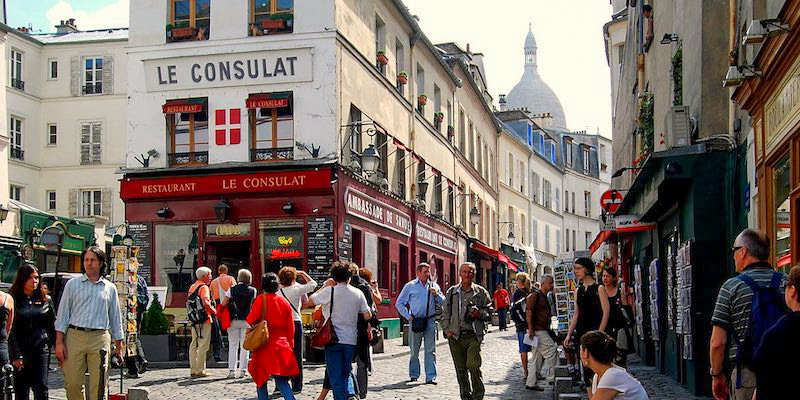 Streets of Montmartre village, 18th Arrondissement, photo Wikimedia by Albany Tim
Streets of Montmartre village, 18th Arrondissement, photo Wikimedia by Albany Tim
The quartier of Montmartre was formerly a village of the same name, high up on the hill above Paris. It encompasses the 18th Arrondissement, which runs up from the border of the 9th right up to the northernmost edge of the city. This hilltop neighborhood has been home to famous (and not-so-famous) painters and writers, most notably Picasso, Renoir, and van Gogh. From its perch on a hill, Montmartre has spectacular views, especially from the big white church of Sacre Coeur. It's also home to the Moulin Rouge. There's more in our guide.
The 19th Arrondissement – Music, Science & Parks
 Night view of Parc de la Villette, 19th Arrondissement
Night view of Parc de la Villette, 19th Arrondissement
A bustling neighborhood, with one of the largest populations in Paris, the 19th Arrondissement offers a lot to explore. Home to Parc de la Villette, which features a cluster of museums including the Cité des Sciences, Cité de la Musique, and the spectacular Philharmonie de Paris, one of the world's great concert halls. The 19th's other large park, Buttes Chaumont, sports a tall waterfall, nature walking paths, and a pedestrian bridge. We'll tell you what makes this neighborhood exciting.
The 20th Arrondissement – Belleville
 Pere Lachaise Cemetery, photo by Mark Craft
Pere Lachaise Cemetery, photo by Mark Craft
On the eastern edge of Paris, the 20th Arrondissement is a long, half-hour Metro ride from central Paris. It's where you find the fascinating Pere Lachaise Cemetery, final resting place of the rich and infamous. The 20th is also worth visiting for the bustling community of Belleville. Come along as we visit eight things we love about this district of Paris.
La Défense
 La Grande Arche at La Défense, photo from Wikipedia, by Feydey
La Grande Arche at La Défense, photo from Wikipedia, by Feydey
La Défense is the modern business district of Paris, located six or seven kilometres west of the central city but very visible (due to its collection of soaring skyscrapers) from such vantage points as the Arc de Triomphe, the Eiffel Tower, and even Montmartre. It surprised us to learn that this modernistic collection of buildings gets eight million visitors a year. Let's take a look at the best reasons for heading west.
![]()
Find Hotel Deals for Your Dates in Paris
Check the complete list of Paris hotels to find current sale prices on rooms in every arrondissement. Save 10%, 20%… or even more! |
Paris Hotel Deals |
Find Hotel Deals for Your Dates in Paris
Save on hotels in every arrondissement of Paris – the Latin Quarter, Saint Germain, the Right Bank, the Marais, near the Eiffel Tower. Save 10%, 20%… or even more! |
Paris Arrondissements – Then There Were 17
 Map of the Paris Arrondissements, Wikimedia by Eric Gaba & Mark Craft
Map of the Paris Arrondissements, Wikimedia by Eric Gaba & Mark Craft
As Paris grew from a small town centered on the islands, more municipal districts were required to administer the city. In the 1860s the city expanded in one giant gulp by incorporating nearby villages into the larger urban entity and creating the familiar twenty arrondissements.
And that's how Paris remained from 1860 until the summer of 2020 when the center of Paris — the four arrondissements with the smallest numbers (including the islands) — were amalgamated into a new administrative district called Paris Central, with the mairie of the 3rd Arrondissement becoming the town hall of the new district. While Paris now has only seventeen arrondissements, we continue to think of arrondissements one through four as separate "little cities" and write about them individually. (To us, Pluto's still a planet.)
As a visitor, you'll discover that the individual Paris arrondissements have their own feel and attractions. You may not make it to all the Paris arrondissements, but this guide will help you focus on the important places to see and things to do in each district. The map above shows the numbers of the Paris arrondissements as well as the names of the neighborhoods. Click on the map for a larger version.
Fascinating Facts About Paris Arrondissements
In 1860, under Napoleon III, Paris expanded its borders, incorporating nearby towns and villages such as Montmartre and Belleville, transforming the city into the 20 arrondissements we know today. Prior to this, Paris had only 12 arrondissements, arranged west to east. The new districts are numbered in a unique spiral pattern, beginning with the 1st Arrondissement in the city center, circling outward like a snail's shell.
The Marais, built over ancient marshlands, became the fashionable hub for the aristocracy from the 13th to 17th centuries, while the Latin Quarter takes its name from the university students who spoke Latin during the Middle Ages. This vibrant neighborhood is still famous for its Roman history and lively food markets.
Did you know the 12th arrondissement is the largest? Thanks to the Bois de Vincennes, it slightly edges out the 16th arrondissement by just a few acres. Montmartre, once a quaint village high on a hill, now forms the lively 18th arrondissement, drawing artists and visitors alike.
Paris' postal codes end in the arrondissement number, so the 1st is 75001, the 4th is 75004, and so on. Look closely, and you'll still spot old street names and arrondissement numbers carved into the sides of historic buildings, a daily reminder of Paris' evolution.
Paris Planning Guides
 Left Bank Hotels
Left Bank Hotels |
 Skip-the-line Louvre Tour
Skip-the-line Louvre Tour |
 Glorious Dinner Cruises
Glorious Dinner Cruises |
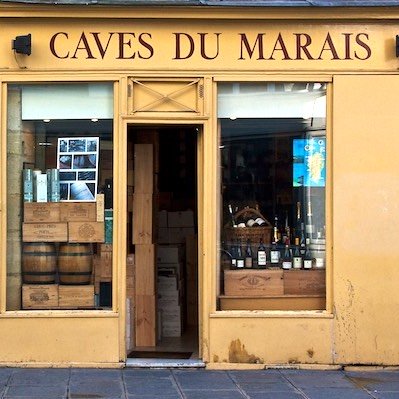 Guide to the Marais
Guide to the Marais |







